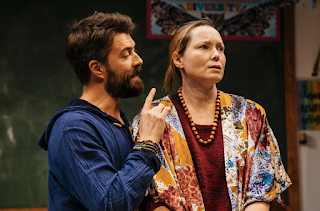Up front, I need to mention that it was an extra pleasure because our son was in the play. This is not a review; however, I am sure you are well aware that any theater piece that one’s son or daughter are in, is perfection. Here is the cast from left to right, Kate Bergeron as Logan (the teacher) – Patrick MacDonald as Caden (the Professor) - Jess Haring as Alicia (the actress) and Hunter Hans Stiebel as Jaxton (Logan’s Paramour).
I feared it would be a heavy exposition on how historically wrong the Anglo celebration of Thanksgiving is. Instead, knowing it would have a mostly Anglo audience, the author took a far more accessible approach, a satire making fun of the Anglos for their naivete, their pride in their fantasies, as well as their ignorance of history. I have rarely laughed so much in a theater. In fact, some of the audience laughed so loud one would miss a line here and there. Seems we have the same issue regarding “Critical Race Theory”. Come to think of it there is not much difference.
Surprising myself, I only thought of the messages that the play had after the piece was over. This 4-person play is a send up of Political Correctness. The premise is that a fourth-grade teacher must put on a play for her students for which she has received a grant that specifies that she will have Native American input. She used the money to hire a Native American only to find out she is an actress who only plays the part of an Indian when she is not playing other ethnicities (Jess). Larissa FastHorse says one reason she wrote the play was in response to people who said they could not find Native American actors. It did not take me long to think of the first one I saw: television in the 1950’s and The Lone Ranger and his side kick Tonto who in real life was Jay Silverheels a Canadian Mohawk.
One of the men in the play is a history professor (Caden) who has always wanted to work in theater with “real” actors, though he is not sure in what role. He joins the group having already written a script with no idea that the concept of the teacher/director (Logan) is that they would come together with the Native American to develop it from scratch. Every once in a while, he inserts uncomfortable facts about the “settling” of the United States. The teacher keeps worrying, will she lose her grant; is this concept too difficult or not appropriate for the kids; how will the school board react, --- all issues that every teacher must now worry about. This dilemma is exemplified by one of the characters who says, “We don’t need actual Native Americans to tell a Native American Story. I mean, none of us are actually Pilgrims, are we?” Here are frustrated Logan and Jaxton in a similar scene in Santa Fe and at the Geffen Playhouse.
A theater professor at the University of Massachusetts, Amherst has said, “The importance and value of this play is theater being this mirror to hold up to society.” Isn’t that what good theater should always do and as a result make us think? In this case it also makes us laugh.




No comments:
Post a Comment